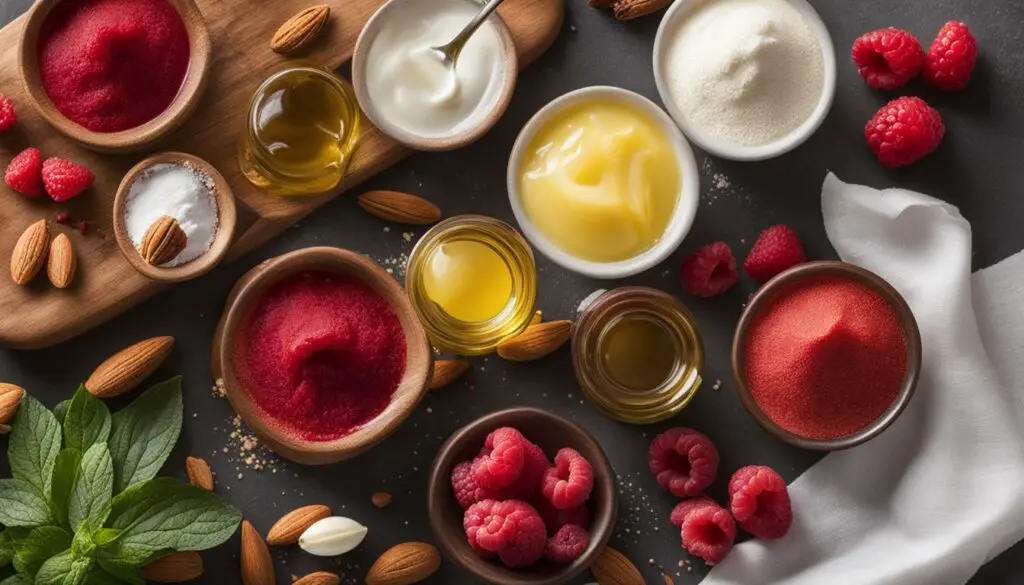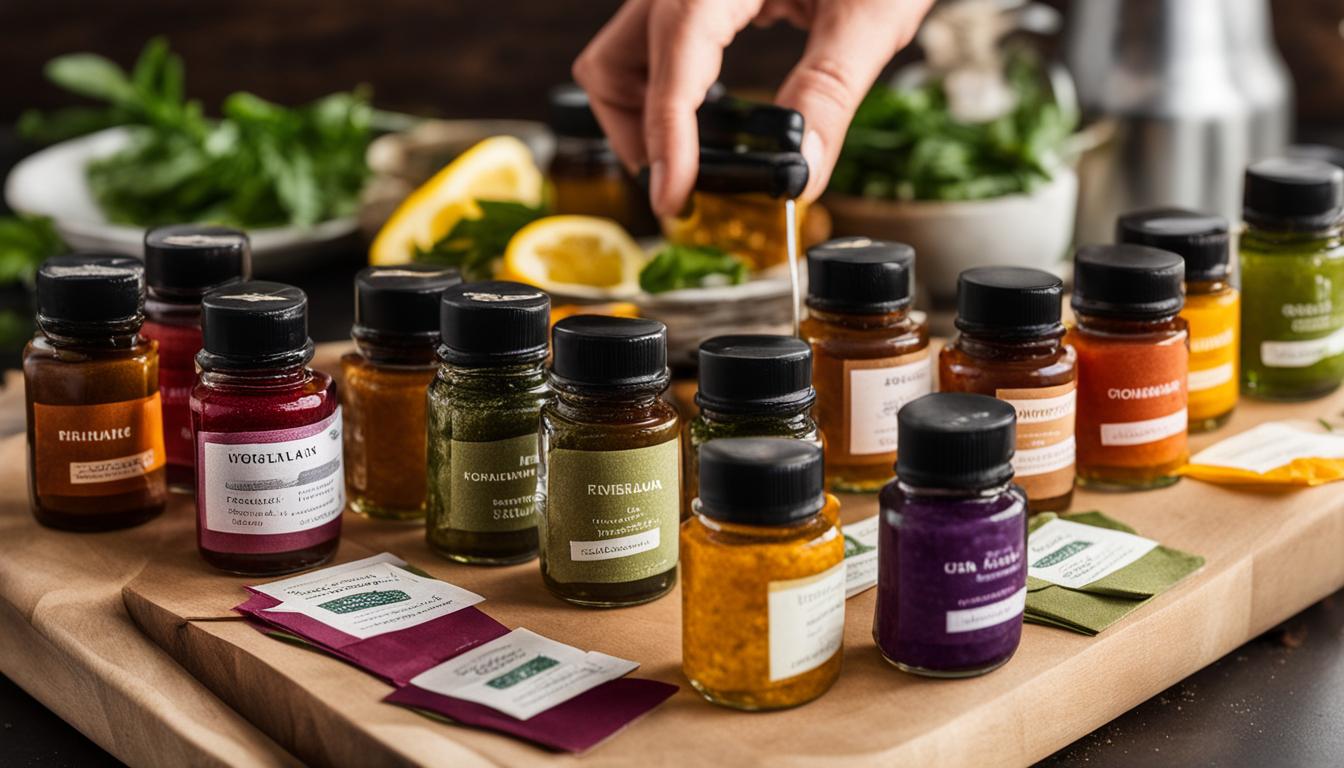Have you ever found a recipe that looks perfect, but then you realize you don’t have the required extract on hand? Or maybe you want to mix things up and try a new flavor in your favorite dish? Whatever the reason may be, the question remains: can you change extracts for recipes?
The good news is, the answer is yes! There are plenty of recipe extract substitutes that can be used to replace traditional options while still maintaining the overall taste and aroma of the dish. By swapping recipe extracts, you can add a new level of excitement to your culinary creations.
In this article, we will explore the possibility of changing extracts in recipes and provide you with some tips and tricks on using substitutes for recipe extracts. Discover how you can add a new twist to your favorite dishes by swapping out different extracts!
Contents
- 1 Understanding Recipe Extracts and Their Role in Cooking
- 2 Reasons for Changing Extracts in Recipes
- 3 Swapping Extracts: A Guide to Substituting Recipe Extracts
- 4 Popular Extract Substitutes for Common Recipes
- 5 Experimenting with Flavor Combinations
- 6 Adjusting Recipes for Dietary Restrictions
- 7 Tips for Successful Extract Swaps
- 8 Enhancing Homemade Extracts
- 9 Exploring Unconventional Extract Options
- 10 Conclusion
- 11 FAQ
- 11.1 Can you change extracts for recipes?
- 11.2 What are some recipe extract substitutes?
- 11.3 How do I swap recipe extracts?
- 11.4 What are some popular extract substitutes for common recipes?
- 11.5 How can I experiment with flavor combinations?
- 11.6 Can changing extracts in recipes accommodate dietary restrictions?
- 11.7 What are some tips for successful extract swaps?
- 11.8 How can I enhance homemade extracts?
- 11.9 Are there unconventional extract options I can explore?
Key Takeaways:
- Recipe extract substitutes can be used to replace traditional options.
- Changing extracts in recipes can add a new level of excitement to your culinary creations.
- By swapping recipe extracts, you can try new flavor combinations.
- Proper measurements and ratios are important when substituting extracts.
- Consider dietary restrictions when making extract swaps.
Understanding Recipe Extracts and Their Role in Cooking
Recipe extracts are concentrated flavorings that can be added to recipes to enhance their taste and aroma. They are made by steeping natural ingredients, such as fruits, herbs, and spices, in alcohol or water. The liquid is then bottled and sold as an extract, which can be used in various recipes.
There are many different types of recipe extracts available, each with its own unique flavor profile. Common extracts include vanilla, almond, mint, and lemon, but there are also more unusual flavors, such as maple, lavender, and rosewater.
Extracts are an important tool in a cook’s arsenal, as they allow you to add intense flavor to your dishes without having to add extra liquid. They are particularly useful in recipes where the addition of extra liquid would negatively affect the texture or consistency of the dish, such as in baked goods.
When using recipe extracts, it’s important to keep in mind that a little goes a long way. They are highly concentrated, so you only need to use a small amount to achieve the desired flavor. It’s also important to use high-quality extracts to ensure the best possible flavor in your dishes.
The Role of Extracts in Cooking
Recipe extracts play a crucial role in cooking, as they help to bring out the natural flavors of the ingredients in a recipe. They are particularly useful in recipes where the flavor of certain ingredients may be muted, such as in cakes or cookies where the butter or sugar may overpower other flavors.
Extracts can also be used to create new and interesting flavor combinations in your dishes. For example, you can use almond extract instead of vanilla in a recipe to give it a nutty flavor, or lemon extract instead of orange in a recipe to give it a tangy twist.
In summary, recipe extracts are an essential component of many recipes, providing intense flavor without the need for extra liquid. There are many different types of recipe extracts available, each with its own unique flavor profile, and they can be used to enhance the taste and aroma of a wide variety of dishes.
Reasons for Changing Extracts in Recipes
There are various reasons why you may want to replace recipe extracts in your dishes. One of the most common reasons is to accommodate dietary restrictions. For example, some people may be allergic to certain extracts or may follow a specific diet that restricts certain ingredients.
Another reason for changing extracts is to experiment with different flavors and create a unique taste profile. By swapping out traditional extracts for alternative options, you can add a new twist to your favorite recipes and create exciting new dishes.
Replacing recipe extracts can also be a cost-effective way to create flavorful dishes without having to purchase expensive ingredients. In some cases, alternative extracts may already be in your pantry, making it easy to try out different flavor combinations without breaking the bank.
Whether you’re looking to accommodate dietary restrictions, experiment with new flavors, or save money, changing recipe extracts can be a fun and rewarding way to enhance your culinary creations.
Alternative Recipe Extracts
There are many alternative recipe extracts that you can use to replace traditional options in your dishes. Here are just a few examples:
| Extract Type | Alternative Options |
|---|---|
| Vanilla extract | Maple extract, almond extract, coconut extract |
| Peppermint extract | Spearmint extract, wintergreen extract |
| Lemon extract | Lime extract, orange extract |
These are just a few examples of the many alternative recipe extracts that you can use to replace traditional options in your dishes. By experimenting with different extracts, you can create exciting new flavor profiles that will keep your taste buds guessing!
Swapping Extracts: A Guide to Substituting Recipe Extracts

Changing extracts in recipes can add a new level of creativity and excitement to your dishes. However, it’s important to understand the proper techniques for swapping out extracts to ensure the desired taste and aroma in your culinary creations.
To effectively substitute recipe extracts, consider the following:
Ratio
When swapping out extracts, it’s important to maintain the proper ratio of ingredients in the recipe. While some extracts may have a stronger flavor than others, it’s best to start with the recommended measurement and adjust as needed.
Flavor Compatibility
When subbing extracts in recipes, consider the overall flavor profile of the dish. Certain extracts may complement or clash with other ingredients in the recipe, so it’s important to choose a substitute that enhances rather than detracts from the dish.
Technique
The technique used for swapping extracts can also affect the final result. Some extracts are more potent when added at the beginning of the cooking process, while others should be added towards the end to avoid overpowering the dish. Experiment with different techniques to find the best method for your recipe.
By following these tips and tricks, you can successfully swap out recipe extracts and create unique and delicious flavors in your dishes. Try using different extracts to add a new twist to your favorite recipes!
Popular Extract Substitutes for Common Recipes

If you’re looking to swap out a recipe extract, there are plenty of alternatives that can give your dish a unique twist. Here are some popular extract substitutes:
| Recipe Extract | Alternative Extract |
|---|---|
| Vanilla extract | Maple extract |
| Almond extract | Coconut extract |
| Lemon extract | Orange extract |
When swapping extracts, it’s important to consider the flavor profile you’re going for. For example, if you’re making a cake and want to replace vanilla extract with maple extract, keep in mind that the flavor may be stronger and you may need to adjust the amount used.
Another option to consider is experimenting with different extracts altogether. For example, if a recipe calls for almond extract, try using hazelnut extract instead for a unique twist.
Remember, there’s no hard and fast rule for swapping extracts in recipes. The key is to experiment and have fun with different flavor combinations!
Don’t be afraid to try different extracts to discover your new favorite flavor combination!
Experimenting with Flavor Combinations

Swapping out recipe extracts allows you to get creative with flavor combinations and experiment with new tastes. By mixing and matching different alternative recipe extracts, you can create unique flavor profiles in your dishes that will tantalize your taste buds. Here are some tips on how to get started:
- Start with small amounts: when experimenting with flavor combinations, start with small amounts to avoid overpowering your dish.
- Consider your ingredients: think about the flavors of the other ingredients in your recipe and choose extracts that will complement them.
- Try contrasting flavors: experiment with contrasting flavors, such as adding almond extract to a chocolatey dessert.
- Mix extracts: try mixing extracts together to create unique flavor combinations. For example, mixing vanilla and orange extract can add a surprising twist to baked goods.
Example Flavor Combinations
| Extract | Complimentary Flavors | Example Recipe |
|---|---|---|
| Almond Extract | Chocolate, berries, stone fruits | Chocolate Almond Biscotti |
| Orange Extract | Chocolate, vanilla, berries | Orange Creamsicle Cupcakes |
| Mint Extract | Chocolate, berries | Chocolate Mint Brownies |
By experimenting with flavor combinations and swapping out recipe extracts, you can create a world of exciting new tastes in your cooking. So don’t be afraid to get creative and try something new!
Adjusting Recipes for Dietary Restrictions
If you or someone you’re cooking for has dietary restrictions, changing extracts in recipes can help accommodate those needs. By using alternative recipe extracts, you can still enjoy the same delicious flavors in your favorite recipes without compromising on taste. Here are some recipe extract substitutes to consider:
| Extract | Alternative Extract |
|---|---|
| Vanilla extract | Non-dairy vanilla extract |
| Almond extract | Non-nut extract (such as orange or lemon) |
| Coffee extract | Instant coffee or espresso powder |
| Peppermint extract | Peppermint oil or fresh mint leaves |
When choosing an alternative extract, be sure to consider the flavor profile of the dish you’re making. For example, if you’re making a chocolate cake and replacing vanilla extract with almond extract, the almond flavor may not complement the chocolate as well as vanilla would.
Remember to always check ingredient labels to ensure that the alternative extract you choose is suitable for your dietary needs.
Note: Always consult with a healthcare professional or registered dietitian before making dietary changes.
Tips for Successful Extract Swaps

Substituting recipe extracts can be a fun and creative way to enhance your dishes’ flavors. Here are some tips to ensure successful extract swaps:
- Consider Flavor Compatibility:
- Proper Measurements:
- Ratio:
- Testing:
When subbing extracts in recipes, it’s essential to consider the flavor compatibility of the ingredients. For example, vanilla extract is a versatile flavor that complements sweet and savory dishes well. On the other hand, almond extract may not be suitable for all recipes and can overpower other flavors.
It’s crucial to use the proper measurements when substituting extracts in recipes. Different extracts have different concentration levels, and using too much or too little can affect the dish’s taste and aroma. As a general rule, use a 1:1 ratio when substituting extracts.
Some extracts, such as peppermint, are potent and should be used in small quantities to avoid overpowering the dish’s flavor. On the other hand, milder extracts, such as lemon, may require a more substantial amount to achieve the desired taste.
Before incorporating a new extract into a recipe, it’s always recommended to do a taste test. Start with a small amount and work your way up to achieve the perfect flavor profile.
Example Table:
| Extract | Substitute |
|---|---|
| Coffee Extract | Espresso Powder |
| Lemon Extract | Lemon Zest |
| Rum Extract | Dark Rum |
Using these tips and techniques, you can successfully sub recipe extracts to create unique and exciting flavors in your dishes. Remember to experiment with different extract options and ratios to achieve the desired taste. Happy Cooking!
Enhancing Homemade Extracts
If you’re a fan of making your own extracts, you can take them to the next level by incorporating different flavors. You can create unique and customized homemade extracts that will add a personal touch to your recipes.
One way to enhance homemade extracts is by replacing some of the existing flavors. For example, you can replace vanilla extract with almond extract or mix both flavors for a unique taste. You can also try combining different fruit extracts, like strawberry and raspberry, for a delicious berry blend.
Another way to enhance homemade extracts is by combining them with other ingredients. For instance, you can infuse your homemade vanilla extract with lavender or cinnamon to add a new dimension of flavor. You can also add fresh mint or lemon zest to your homemade extracts for a refreshing twist.
If you prefer a visual guide, check out this table for some inspiration:
| Original Extract | New Extract | Description |
|---|---|---|
| Vanilla | Almond | A nuttier, slightly sweet flavor that will complement pastries and desserts. |
| Mint | Lemon | A refreshing combination that will add a zesty kick to your cocktails and desserts. |
| Coffee | Cinnamon | A warm and spicy flavor that will complement baked goods and desserts. |
| Orange | Cardamom | A unique and exotic flavor that will add depth to your savory and sweet dishes. |
Experiment with different flavor combinations and find what works best for your taste. Remember to label your homemade extracts with the flavors you used for future reference.
Exploring Unconventional Extract Options

If you’re looking to take your cooking to the next level, why not consider experimenting with unconventional extract options? While vanilla, almond, and mint extracts may be the most commonly used options, there are plenty of other extracts available that can add a unique twist to your dishes.
One unconventional extract option to consider is lavender extract. This floral extract can add a delicate and fragrant flavor to baked goods like cakes and scones. It also pairs well with lemon, making it a great addition to citrus-based desserts.
Another unique extract option is maple extract. This extract can add a sweet and smoky flavor to glazes, marinades, and even coffee. Try adding a few drops to your pancake batter for a delicious maple flavor without the added sugar.
| Extract Option | Flavor Profile | Best Used In |
|---|---|---|
| Lavender | Fragrant, Floral | Baked Goods |
| Maple | Sweet, Smoky | Glazes, Marinades, Coffee |
| Coconut | Creamy, Nutty | Smoothies, Baked Goods, Cocktails |
Coconut extract is another option worth exploring. This extract can add a creamy, nutty flavor to smoothies, baked goods, and even cocktails. It pairs well with tropical fruits like pineapple and mango and can also be used to add a subtle coconut flavor to savory dishes like curries and soups.
Don’t be afraid to get creative and try new extract options in your cooking. Who knows, you might just discover a new favorite flavor combination!
Conclusion
Changing extracts in recipes can add a whole new dimension to your cooking. With a little knowledge and experimentation, you can create unique and exciting flavor profiles that will take your dishes to the next level. Remember that different extracts have different strengths and flavor notes, so it’s important to consider the ratios and compatibility of the flavors when making extracts swaps.
So, can you change extracts for recipes? Absolutely! It’s all about finding the right substitute that complements the other ingredients in your dish. Whether you’re accommodating a dietary restriction or simply looking to explore new flavors, there are plenty of alternative recipe extracts to choose from.
Use these tips and tricks to confidently sub out recipe extracts and create delicious, one-of-a-kind dishes that will wow your family and friends. Don’t be afraid to mix and match extracts for an unexpected flavor twist, or to experiment with unconventional extract options. The possibilities are endless!
FAQ
Can you change extracts for recipes?
Yes, you can change extracts in recipes. There are various substitutes available that can be used to swap out different extracts and add a new twist to your favorite dishes.
What are some recipe extract substitutes?
Some common recipe extract substitutes include using fresh ingredients such as fruit zest or juice, spices, flavored oils, or other extracts with similar flavor profiles.
How do I swap recipe extracts?
To effectively swap recipe extracts, it’s recommended to follow recommended ratios and techniques. You can replace the extract with an equal amount of substitute to ensure the desired taste and aroma in your dish.
What are some popular extract substitutes for common recipes?
Popular extract substitutes for common recipes include using vanilla extract instead of almond extract, lemon extract instead of orange extract, or mint extract instead of peppermint extract.
How can I experiment with flavor combinations?
You can experiment with flavor combinations by mixing and matching different extracts. Try combining extracts such as vanilla and coconut, or cinnamon and nutmeg, to create delightful and unexpected flavor profiles.
Can changing extracts in recipes accommodate dietary restrictions?
Yes, changing extracts in recipes can help accommodate dietary restrictions. There are alternative recipe extracts available, such as gluten-free or dairy-free options, that can be used for specific dietary needs.
What are some tips for successful extract swaps?
Some tips for successful extract swaps include considering flavor compatibility, using proper measurements and ratios, and being aware of any dietary restrictions when substituting extracts in recipes.
How can I enhance homemade extracts?
You can enhance homemade extracts by replacing or combining existing extracts with different flavors. This can help create unique and personalized extracts for your recipes.
Are there unconventional extract options I can explore?
Yes, you can explore unconventional extract options to add a surprising twist to your dishes. Try using extracts such as lavender, rose, or maple bacon to spark your creativity in the kitchen.









